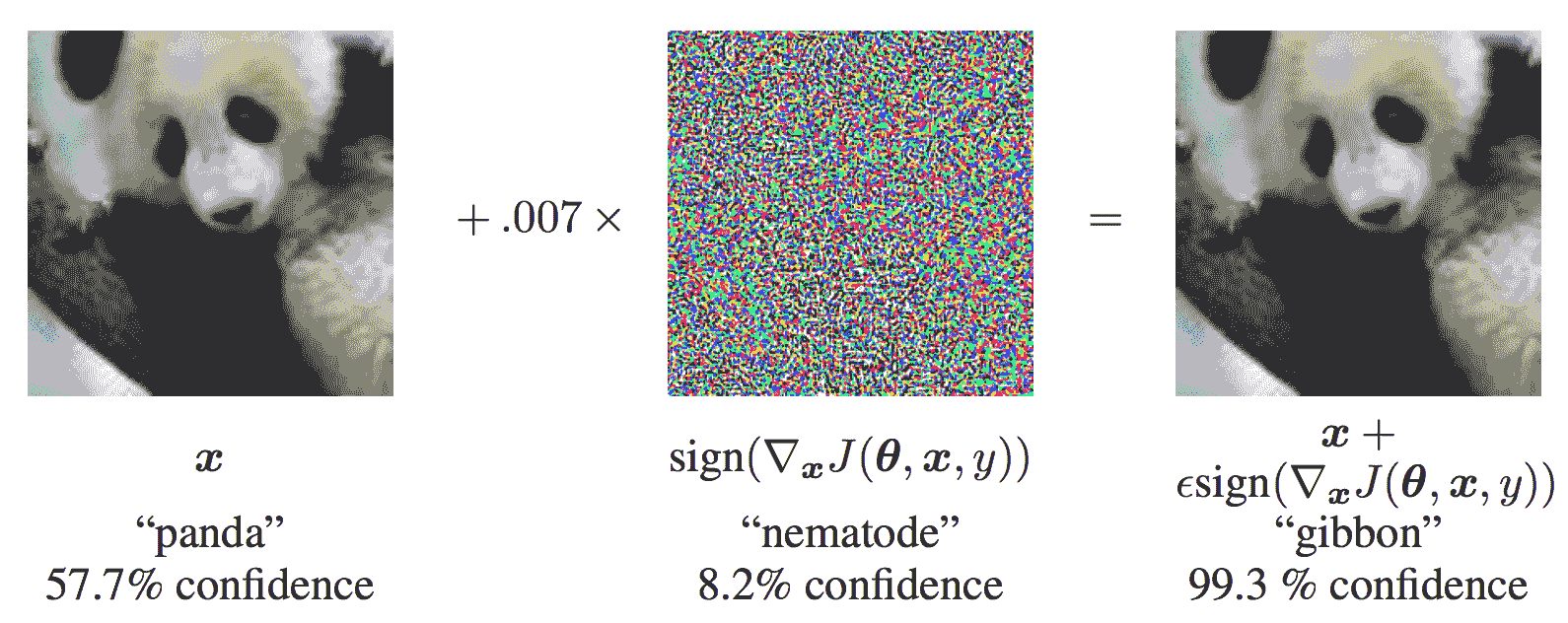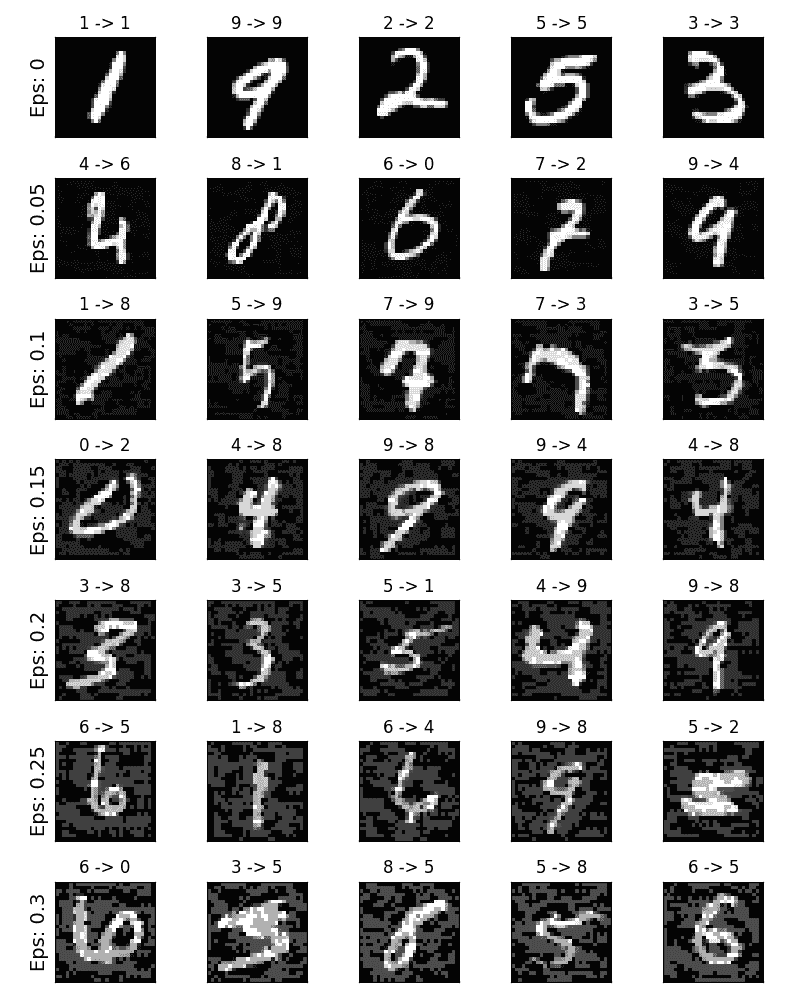对抗示例生成
对抗示例生成
原文:https://pytorch.org/tutorials/beginner/fgsm_tutorial.html
作者: Nathan Inkawhich
如果您正在阅读本文,希望您能体会到某些机器学习模型的有效性。 研究不断推动 ML 模型更快,更准确和更高效。 但是,设计和训练模型的一个经常被忽略的方面是安全性和鲁棒性,尤其是在面对想要欺骗模型的对手的情况下。
本教程将提高您对 ML 模型的安全漏洞的认识,并深入了解对抗性机器学习的热门话题。 您可能会惊讶地发现,在图像上添加无法察觉的扰动会导致完全不同的模型表现。 鉴于这是一个教程,我们将通过图像分类器上的示例来探讨该主题。 具体而言,我们将使用最流行的一种攻击方法,即快速梯度符号攻击(FGSM)来欺骗 MNIST 分类器。
威胁模型
就上下文而言,有多种类型的对抗性攻击,每种攻击者的目标和假设都不同。 但是,总的来说,总体目标是向输入数据添加最少的扰动,以引起所需的错误分类。 攻击者的知识有几种假设,其中两种是:白盒和黑盒。 白盒攻击假定攻击者具有完全的知识并可以访问模型,包括架构,输入,输出和权重。 黑盒攻击假定攻击者只能访问模型的输入和输出,并且对底层架构或权重一无所知。 目标也有几种类型,包括错误分类和源/目标错误分类。 错误分类意味着对手只希望输出分类错误,而不在乎新分类是什么。 源/目标错误分类意味着对手想要更改最初属于特定源类别的图像,以便将其分类为特定目标类别。
在这种情况下,FGSM 攻击是白盒攻击,目标是错误分类。 有了这些背景信息,我们现在可以详细讨论攻击了。
快速梯度符号攻击
迄今为止,最早的也是最流行的对抗性攻击之一被称为快速梯度符号攻击(FGSM),由《解释和利用对抗性示例》(Goodfellow 等)描述。 攻击非常强大,而且直观。 它旨在利用神经网络学习梯度的方式来攻击神经网络。 这个想法很简单,不是通过基于反向传播的梯度来调整权重来使损失最小化,攻击会基于相同的反向传播的梯度来调整输入数据,以使损失最大化。 换句话说,攻击使用损失相对于输入数据的梯度,然后调整输入数据以使损失最大化。
在进入代码之前,让我们看一下著名的 FGSM Pandas 示例,并提取一些符号。

从图中,x是正确分类为“Pandas”的原始输入图像,y是x的输出,θ表示模型参数,而J(θ, x, y)是用于训练网络的损失。 攻击会将梯度反向传播回输入数据,以计算ᐁ[x] J(θ, x, y)。 然后,它会沿方向(即ᐁ[x] J(θ))沿一小步(图片中的ε或0.007)调整输入数据,(x, y),这将使损失最大化。 然后,当目标图像仍明显是“Pandas”时,目标网络将它们误分类为“长臂猿”。
希望本教程的动机已经明确,所以让我们跳入实现过程。
from __future__ import print_function
import torch
import torch.nn as nn
import torch.nn.functional as F
import torch.optim as optim
from torchvision import datasets, transforms
import numpy as np
import matplotlib.pyplot as plt
实现
在本节中,我们将讨论本教程的输入参数,定义受到攻击的模型,然后编写攻击代码并运行一些测试。
输入
本教程只有三个输入,定义如下:
epsilons-用于运行的ε值列表。 在列表中保留 0 很重要,因为它表示原始测试集上的模型表现。 同样,从直觉上讲,我们期望ε越大,扰动越明显,但是从降低模型准确率的角度来看,攻击越有效。 由于此处的数据范围为[0,1],因此ε值不得超过 1。pretrained_model-使用pytorch/examples/mnist训练的 MNIST 模型的路径。 为简单起见,请在此处下载预训练模型。use_cuda-布尔标志,如果需要和可用,则使用 CUDA。 请注意,具有 CUDA 的 GPU 在本教程中并不重要,因为 CPU 不会花费很多时间。
epsilons = [0, .05, .1, .15, .2, .25, .3]
pretrained_model = "data/lenet_mnist_model.pth"
use_cuda=True
受到攻击的模型
如前所述,受到攻击的模型与pytorch/examples/mnist中的 MNIST 模型相同。 您可以训练并保存自己的 MNIST 模型,也可以下载并使用提供的模型。 这里的网络定义和测试数据加载器已从 MNIST 示例中复制而来。 本部分的目的是定义模型和数据加载器,然后初始化模型并加载预训练的权重。
# LeNet Model definition
class Net(nn.Module):
def __init__(self):
super(Net, self).__init__()
self.conv1 = nn.Conv2d(1, 10, kernel_size=5)
self.conv2 = nn.Conv2d(10, 20, kernel_size=5)
self.conv2_drop = nn.Dropout2d()
self.fc1 = nn.Linear(320, 50)
self.fc2 = nn.Linear(50, 10)
def forward(self, x):
x = F.relu(F.max_pool2d(self.conv1(x), 2))
x = F.relu(F.max_pool2d(self.conv2_drop(self.conv2(x)), 2))
x = x.view(-1, 320)
x = F.relu(self.fc1(x))
x = F.dropout(x, training=self.training)
x = self.fc2(x)
return F.log_softmax(x, dim=1)
# MNIST Test dataset and dataloader declaration
test_loader = torch.utils.data.DataLoader(
datasets.MNIST('../data', train=False, download=True, transform=transforms.Compose([
transforms.ToTensor(),
])),
batch_size=1, shuffle=True)
# Define what device we are using
print("CUDA Available: ",torch.cuda.is_available())
device = torch.device("cuda" if (use_cuda and torch.cuda.is_available()) else "cpu")
# Initialize the network
model = Net().to(device)
# Load the pretrained model
model.load_state_dict(torch.load(pretrained_model, map_location='cpu'))
# Set the model in evaluation mode. In this case this is for the Dropout layers
model.eval()
出:
Downloading http://yann.lecun.com/exdb/mnist/train-images-idx3-ubyte.gz to ../data/MNIST/raw/train-images-idx3-ubyte.gz
Extracting ../data/MNIST/raw/train-images-idx3-ubyte.gz to ../data/MNIST/raw
Downloading http://yann.lecun.com/exdb/mnist/train-labels-idx1-ubyte.gz to ../data/MNIST/raw/train-labels-idx1-ubyte.gz
Extracting ../data/MNIST/raw/train-labels-idx1-ubyte.gz to ../data/MNIST/raw
Downloading http://yann.lecun.com/exdb/mnist/t10k-images-idx3-ubyte.gz to ../data/MNIST/raw/t10k-images-idx3-ubyte.gz
Extracting ../data/MNIST/raw/t10k-images-idx3-ubyte.gz to ../data/MNIST/raw
Downloading http://yann.lecun.com/exdb/mnist/t10k-labels-idx1-ubyte.gz to ../data/MNIST/raw/t10k-labels-idx1-ubyte.gz
Extracting ../data/MNIST/raw/t10k-labels-idx1-ubyte.gz to ../data/MNIST/raw
Processing...
Done!
CUDA Available: True
FGSM 攻击
现在,我们可以通过干扰原始输入来定义创建对抗示例的函数。 fgsm_attack函数接受三个输入,image是原始的干净图像(x),epsilon是像素级扰动量ε,data_grad是输入图像损失的梯度(ᐁ[x] J(θ, x, y))。 该函数然后创建扰动图像为

最后,为了维持数据的原始范围,将被扰动的图像裁剪到范围[0,1]。
# FGSM attack code
def fgsm_attack(image, epsilon, data_grad):
# Collect the element-wise sign of the data gradient
sign_data_grad = data_grad.sign()
# Create the perturbed image by adjusting each pixel of the input image
perturbed_image = image + epsilon*sign_data_grad
# Adding clipping to maintain [0,1] range
perturbed_image = torch.clamp(perturbed_image, 0, 1)
# Return the perturbed image
return perturbed_image
测试函数
最后,本教程的主要结果来自test函数。 每次调用此测试函数都会在 MNIST 测试集上执行完整的测试步骤,并报告最终精度。 但是,请注意,此函数还需要epsilon输入。 这是因为test函数报告实力为ε的来自对手的攻击模型的准确率。 更具体地说,对于测试集中的每个样本,函数都会计算输入数据data_grad的损失梯度,并使用fgsm_attack创建一个扰动图像perturbed_data,然后检查受干扰的示例是否具有对抗性。 除了测试模型的准确率外,该函数还保存并返回了一些成功的对抗示例,以供以后可视化。
def test( model, device, test_loader, epsilon ):
# Accuracy counter
correct = 0
adv_examples = []
# Loop over all examples in test set
for data, target in test_loader:
# Send the data and label to the device
data, target = data.to(device), target.to(device)
# Set requires_grad attribute of tensor. Important for Attack
data.requires_grad = True
# Forward pass the data through the model
output = model(data)
init_pred = output.max(1, keepdim=True)[1] # get the index of the max log-probability
# If the initial prediction is wrong, dont bother attacking, just move on
if init_pred.item() != target.item():
continue
# Calculate the loss
loss = F.nll_loss(output, target)
# Zero all existing gradients
model.zero_grad()
# Calculate gradients of model in backward pass
loss.backward()
# Collect datagrad
data_grad = data.grad.data
# Call FGSM Attack
perturbed_data = fgsm_attack(data, epsilon, data_grad)
# Re-classify the perturbed image
output = model(perturbed_data)
# Check for success
final_pred = output.max(1, keepdim=True)[1] # get the index of the max log-probability
if final_pred.item() == target.item():
correct += 1
# Special case for saving 0 epsilon examples
if (epsilon == 0) and (len(adv_examples) < 5):
adv_ex = perturbed_data.squeeze().detach().cpu().numpy()
adv_examples.append( (init_pred.item(), final_pred.item(), adv_ex) )
else:
# Save some adv examples for visualization later
if len(adv_examples) < 5:
adv_ex = perturbed_data.squeeze().detach().cpu().numpy()
adv_examples.append( (init_pred.item(), final_pred.item(), adv_ex) )
# Calculate final accuracy for this epsilon
final_acc = correct/float(len(test_loader))
print("Epsilon: {}\tTest Accuracy = {} / {} = {}".format(epsilon, correct, len(test_loader), final_acc))
# Return the accuracy and an adversarial example
return final_acc, adv_examples
运行攻击
实现的最后一部分是实际运行攻击。 在这里,我们为epsilon输入中的每个ε值运行完整的测试步骤。 对于每个ε,我们还保存最终精度,并在接下来的部分中绘制一些成功的对抗示例。 请注意,随着ε值的增加,打印的精度如何降低。 另外,请注意ε = 0表示原始测试准确率,没有受到攻击。
accuracies = []
examples = []
# Run test for each epsilon
for eps in epsilons:
acc, ex = test(model, device, test_loader, eps)
accuracies.append(acc)
examples.append(ex)
出:
Epsilon: 0 Test Accuracy = 9810 / 10000 = 0.981
Epsilon: 0.05 Test Accuracy = 9426 / 10000 = 0.9426
Epsilon: 0.1 Test Accuracy = 8510 / 10000 = 0.851
Epsilon: 0.15 Test Accuracy = 6826 / 10000 = 0.6826
Epsilon: 0.2 Test Accuracy = 4301 / 10000 = 0.4301
Epsilon: 0.25 Test Accuracy = 2082 / 10000 = 0.2082
Epsilon: 0.3 Test Accuracy = 869 / 10000 = 0.0869
结果
准确率与ε
第一个结果是精度与ε曲线的关系。 如前所述,随着ε的增加,我们预计测试精度会降低。 这是因为更大的ε意味着我们朝着将损失最大化的方向迈出了更大的一步。 请注意,即使ε值是线性间隔的,曲线中的趋势也不是线性的。 例如,ε = 0.05处的精度仅比ε = 0低约 4%,但ε = 0.2处的精度比ε = 0.15。 另外,请注意,模型的准确率在ε = 0.25和ε = 0.3之间达到 10 类分类器的随机准确率。
plt.figure(figsize=(5,5))
plt.plot(epsilons, accuracies, "*-")
plt.yticks(np.arange(0, 1.1, step=0.1))
plt.xticks(np.arange(0, .35, step=0.05))
plt.title("Accuracy vs Epsilon")
plt.xlabel("Epsilon")
plt.ylabel("Accuracy")
plt.show()

对抗示例样本
还记得没有免费午餐的想法吗? 在这种情况下,随着ε的增加,测试精度降低,但扰动变得更容易察觉。 实际上,在攻击者必须考虑的准确率下降和可感知性之间要进行权衡。 在这里,我们展示了每个ε值下成功对抗示例的一些示例。 绘图的每一行显示不同的ε值。 第一行是ε = 0示例,这些示例表示没有干扰的原始“干净”图像。 每张图片的标题均显示“原始分类->对抗分类”。 注意,扰动在ε = 0.15处开始变得明显,而在ε = 0.3处则非常明显。 但是,在所有情况下,尽管增加了噪音,人类仍然能够识别正确的类别。
# Plot several examples of adversarial samples at each epsilon
cnt = 0
plt.figure(figsize=(8,10))
for i in range(len(epsilons)):
for j in range(len(examples[i])):
cnt += 1
plt.subplot(len(epsilons),len(examples[0]),cnt)
plt.xticks([], [])
plt.yticks([], [])
if j == 0:
plt.ylabel("Eps: {}".format(epsilons[i]), fontsize=14)
orig,adv,ex = examples[i][j]
plt.title("{} -> {}".format(orig, adv))
plt.imshow(ex, cmap="gray")
plt.tight_layout()
plt.show()

接下来要去哪里?
希望本教程对对抗性机器学习主题有所了解。 从这里可以找到许多潜在的方向。 这种攻击代表了对抗性攻击研究的最开始,并且由于随后有许多关于如何攻击和防御来自对手的 ML 模型的想法。 实际上,在 NIPS 2017 上有一个对抗性的攻击和防御竞赛,并且本文描述了该竞赛中使用的许多方法:《对抗性的攻击与防御竞赛》。 防御方面的工作还引发了使机器学习模型总体上更健壮的想法,以适应自然扰动和对抗性输入。
另一个方向是不同领域的对抗性攻击和防御。 对抗性研究不仅限于图像领域,请查看对语音到文本模型的这种攻击。 但是,也许更多地了解对抗性机器学习的最好方法是动手。 尝试实现与 NIPS 2017 竞赛不同的攻击,并查看它与 FGSM 有何不同。 然后,尝试保护模型免受自己的攻击。
脚本的总运行时间:(4 分钟 22.519 秒)
下载 Jupyter 笔记本:fgsm_tutorial.ipynb
由 Sphinx 画廊生成的画廊